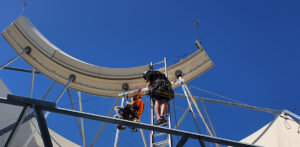Undertaking different types of work requires using different types of PPE. Making sure you have the right protective equipment when working in a high-risk environment is an important part of a holistic approach to safety.
The personal protective equipment (PPE) that will best assist a worker in mitigating risks to safety will differ depending on the job being completed, the environment being worked in and the other safety systems that are in place.
In this blog post, we are going to look at a couple of basic items that workers should have before they start work in some of the more common high-risk scenarios.
Work at heights PPE
One of the biggest issues workers are faced with when it comes to safely working at heights is that the things that constitute a “height” are seemingly endless.
That said, there are a couple of pieces of protective equipment that get used often.
The first is a harness. This is the single most common PPE item used when it comes to working at heights. The harness is worn by the worker and connects to an anchor point or other part of a safety system. Harnesses come in a variety of shapes, sizes as well as different attachment points for different types of work.
It is important that a worker find the harness that is best suited to where they work and the type of work they do.
Rope lines are another common piece of PPE used when working at heights. Ropes are commonly used when a roof has a series of anchor points installed. Paired with carabiners, the worker can safely move across the roof, connecting to each anchor point in sequence.
Alternately, a lanyard is used to provide a connection to either the structure or an anchor point. Twin-tail lanyards (that is, a lanyard with two connectors on it) can be used like a rope line. The worker can use the two attachment points to move through a series of anchor points while remaining safely connected while doing so.
In situations where there is no existing anchor point to connect to, workers often use an anchor strap to create a temporary one. An anchor strap works by being wrapped around a suitable part of the structure in such a way that a worker can use a carabiner or lanyard to connect their harness to it to provide fall protection.
Confined space PPE

Working in and around confined spaces introduces some risks that are like working at heights, along with new risks that need to be mitigated.
Entry into a confined space can often require the use of a harness, like working at heights, as manholes and trenches can also be places where the risk of a fall is present. With confined space work, the harness is often connected to a tripod which is placed over the top of the manhole.
Using winches or pulleys, the worker can be lowered into the confined space safely.
One risk of working in confined spaces that is not often considered properly is the atmosphere becoming hazardous to breathe for workers. To provide warning that evacuation of the area is required, workers can use gas detectors. Gas detectors measure the concentrations of various components of air, and sound an alarm in the event hazardous levels of certain gasses are detected.
In situations where the atmosphere is not safe to breathe, workers can use breathing apparatus to provide a safe way to work in these spaces.
Dust and particulate PPE

Protection against the inhalation of hazardous substances is not just a risk that needs to be mitigated by those working in confined spaces. Asbestos is already known as being extremely dangerous to workers’ health and is abundant across Australia. It was used widely in construction of all types until the mid-1980s when it was finally banned.
More recently, crystalline silica has been highlighted as a substance that carries similar risks to health when its dust is inhaled by workers.
In both cases, a face mask can be used. The mask creates a barrier that allows air to pass through, while stopping the larger dust particles from entering the worker’s airway.
In the case of asbestos, workers should take additional steps as asbestos particles can attach themselves to clothing, tools and other items. Tools used with asbestos containing materials (ACMs) should be isolated from other tools – stored separately and only used for work involving potential asbestos contamination.
Clothing can be protected with a painter’s jumpsuit; footwear can be covered with protective boots. Eyes should also be protected from exposure using protective glasses.
Finding the right PPE for you
It is vital for workers that their safety equipment and PPE be suited to their work, the environment they are working in and the type of work they are doing.
The team at Height Safety Engineers are the experts at protecting people working at heights and other high-risk work. Our training centre at HSE Sydney allows workers to trial popular fall protection harnesses in a controlled environment to ensure they get the harness that works best for them.
We can also hold PPE demonstration events at your workplace or job site. Our goal is to make sure that every worker is using the best PPE for their needs. Discuss your safety equipment needs with our team by calling 1300 884 978 or email enquiries@heightsafety.net.





